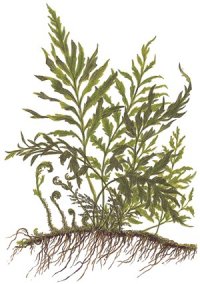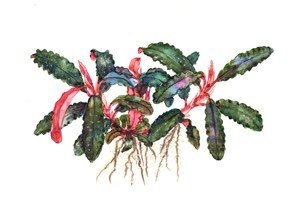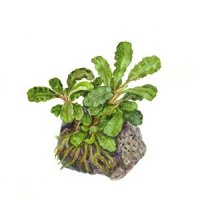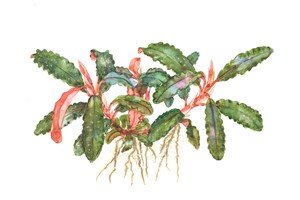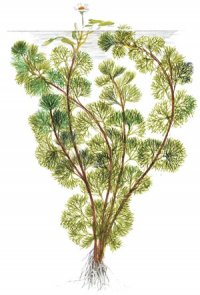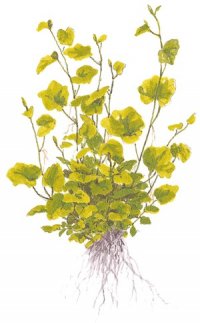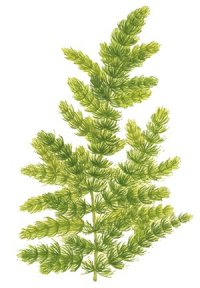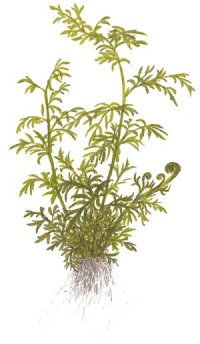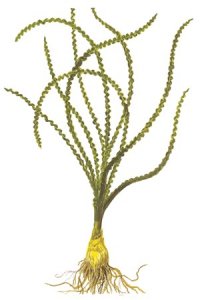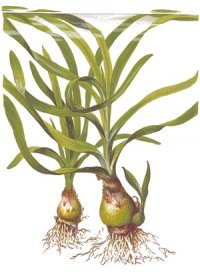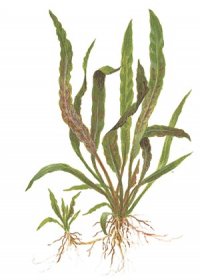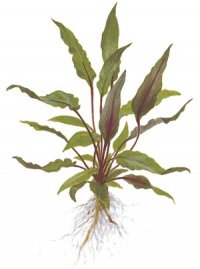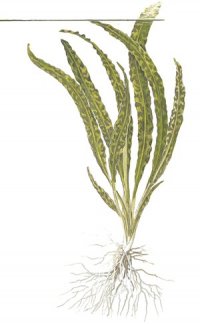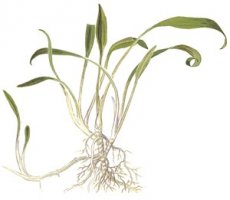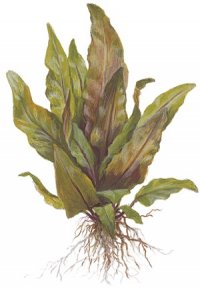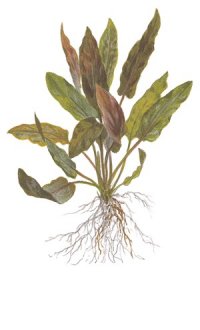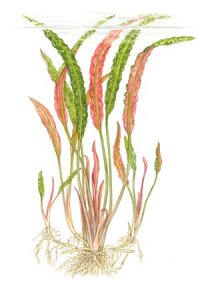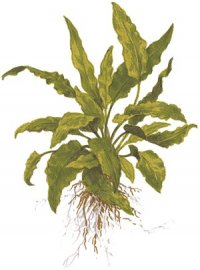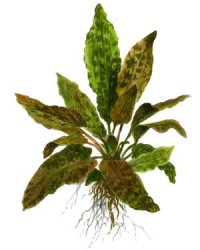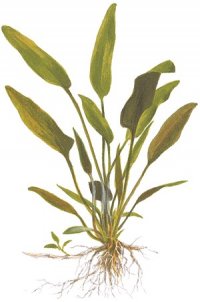-
You are viewing the forum as a Guest, please login (you can use your Facebook, Twitter, Google or Microsoft account to login) or register using this link: Log in or Sign Up
Aquatic Plants
All aquatic plant database
.
Bolbitis comes from West Africa, a fern with beautiful, transparent green leaves, 15-40 cm tall and wide. When planting, do not cover the rhizome because it will rot, and it is best to plant Bolbitis heudelotii on a root or stone. Keep the plant in position with fishing line until it has gained a hold. Easy to propagate by splitting the horizontal rhizome.
Supply of CO2 will considerably enhance the growth, which is only optimal in soft, slightly acidic water.
Source: Tropica
The ‘Kedagang’ is a variety of the Bucephalandra family originated in Borneo.
It is characterized by long, narrow, dark green leaves with white dots. The leaf can be 1-2 cm wide and up to 6 cm long.
The rhizomes are red and similar to the Red variety of Bucephalandra. When immersed, a blue metallic shade may appear on the leaves.
Source: Tropica
In nature, Bucephalandra usually grows on rocks or wood in rivers and streams - much like Anubias, which they resemble regarding use and care in the aquarium.
Bucephalandra 'Wavy Green' is an easy, slow-growing plant that prefers lower light levels. A nice, dense appearance is ensured by the willingness to branch, even without trimming.
The green leaves are 2 cm wide and 5 cm long with wavy edges. Tiny white spots will appear on immerse leaves.
The creeping stem, rhizome, must not be...
The Bucephalandra resemble Anubias very much and should be treated the same way. They usually grow more or less epiphytic in or near water.
Bucephalandra sp. 'Red' does best at lower light levels and is very easy to grow. The leaves are of a very dark green or leathery red colour. Numerous tiny, white dots and sometimes a faint, metallic, blue colour will appear on submerse leaves. Size of leaf is 2-4 cm wide, 4-6 cm long and usually it will present wavy edges.
Do not cover the creeping...
Cabomba is a very popular aquarium plant from South America owing to its beautiful foliage. It reaches 30-80 cm and each stem can become 5-8 cm wide. The least demanding of the Cabomba-species, but still causes problems in poorly lit aquariums. If there is not sufficient light, try Limnophila sessiliflora, which requires less light. Most decorative when planted in groups.
Eaten locally as a vegetable.
A bundle of stems or young plants gathered in an anchor. Remove the anchor and split...
Cardamine lyrata is actually a marsh plant from Japan. But it is also a familiar aquarium plant which thrives under water with 20-50 cm long stems. A characteristic trailing growth form makes it highly decorative, and ‘aerial’ roots often form on the plant itself.
Plant it in groups, and make sure the water temperature does not exceed 28 degrees C (this makes the leaves much smaller and the plant more leggy). Also suitable in garden ponds in the summer.
Source: Tropica
Ceratophyllum demersum 'Foxtail' was found in a smaller tributary in Bolivia during an expedition to Rio Guapore, a boundary river between Brazil and Bolivia. Ceratophyllum has no roots as such, but it is nevertheless possible to plant it in the bottom of an aquarium and stems can become up to 80 cm tall and 5 cm wide. 'Foxtail' differs because its leaves are closer together and it has lateral shoots, which gives it an attractive, compact appearance.
The plant also distinguishes itself...
Ceratopteris thalictroides is a pantropical fern, 15-30 cm high and 10-20 cm wide..
This plant normally grows fast, but the addition of CO2 may be necessary to promote growth. In small, open aquariums, it can grow out of the tank and form beautiful surface leaves. The finely branched leaves are very decorative and provide good contrast to other leaf shapes. In good light Ceratopteris thalictroides grows fast and helps prevent algae by consuming large amounts of nutrients. This makes it a...
Crinum calamistratum from West Africa is a very graceful bulbous plant with dark-green, very narrow leaves. The curly leaves becomes 40-120 cm long. It forms smaller bulbs than the other Crinum-species, and requires less light.
In the aquarium plants that are thriving form a number of small bulbs. It is not eaten by herbivorous fish. It can also be used in brackish aquariums with low salt concentrations.
Source: Tropica
Crinum thaianum from Thailand is a distinctive bulbous plant belonging to the lily family having 60-200 cm long leaves. It is undemanding apart from the fact that it needs plenty of space. Plant so the top 2/3 of the bulb is visible, because otherwise the bulb tends to rot. When the plant grows older it sometimes sends a flower stem up to the water surface with an aromatic, elegant lily flower.
Source: Tropica
This little Cryptocoryne comes from Asia, and grows naturally in for instance Thailand.
The narrow, red-brown leaves have clear, black patterns and beautifully waving leaf edges. Each leaf grows to be about 1-3 cm wide and up to 15 cm long, giving the plant a light and graceful look, which is easy to combine with other plants inside the aquarium, enabling beautiful contrasts.
Like many other Cryptocorynes, it is able to grow under must conditions and can thrive at even very poor light...
Cryptocoryne beckettii 'Petchii' is a small variety of Cryptocoryne beckettii from Sri Lanka, which has beautiful, slightly fluted leaf margins, 10-15 cm long. Leaves become dark olive-brown with violet underside. Like many other Cryptocorynes, the leaf colour and shape depends largely on environmental conditions in the aquarium.
Source: Tropica
Cryptocoryne crispatula var. balansae is from Southern Thailand where there are limestone mountains, and the water can be very hard. Like many other Cryptocorynes it needs to acclimatise before growth starts in earnest. Leaves becomes 20-60 cm long and the single roset plant becomes 15-20 cm wide.
Source: Tropica
Cryptocoryne parva fromac Sri Lanka is the smallest of all Cryptocorynes (only 3-6 cm tall and a roset less than 5-8 cm wide). It is one of the few species that does not significantly change its leaf shape and colour depending on cultivation conditions. It needs more light than most other Cryptocorynes because it almost loses its leaf plate under water. So, it must never be overshadowed by other plants.
Known for its slow growth, but Nutrition Capsules in the bottom layer will enhance the...
The triploid variety of Cryptocoryne undulata from Sri Lanka has wider leaves and a beautiful, flecked leaf pattern.
It also grows larger, from 15-30 cm, and the single roset becomes 10-20 cm wide. It is a hardy plant and do well under many growing conditions.
Source: Tropica
This red version of Cryptocoryne undulata grows wild in rivers of Sri Lanka.
It is an easy plant, tolerant of very different conditions in an aquarium. Appearance of the plant will partially depend on these conditions.
Low levels of light and nutrients will produce a relatively tall, greenish-brown plant of slow growth. Higher levels of light and nutrition, combined with added CO2, will make the plant grow considerably faster producing shorter leaves of a reddish-brown colour.
Source: Tropica
Cryptocoryne usteriana is one of the taller cryptocorynes and is very easy to grow.
Leaves are 3-5 cm wide with an embossed surface; they can easily reach more than 50 cm length.
With good light and fertilization, the upper side of the leaves will obtain a dark green or bronze-green colour while the back of the leaves will turn burgundy red.
Propagation is by long runners, and the plant tolerates quite alkaline water very well.
Source: Tropica
Cryptocoryne wendtii ‘Green' is suitable for small aquariums with a height from 10-15 cm and a roset from 8-15 cm wide. When grown in an open space the leaves will virtually lie on the bottom. Like most other Sri Lanka Cryptocorynes, it also grows well in hard water.
Source: Tropica
This beautiful variety with the dark, hammered leaves is named after 'Tropica'. When grown in an open space the leaves will virtually lie on the bottom. It is suitable for small aquariums with leaves from 10-20 cm, and a rosette from 10-20 cm wide. Like most other Sri Lanka Cryptocorynes, it also grows well in hard water.
Source: Tropica
This Cryptocoryne from Sri Lanka used (mistakenly) to be called Cryptocoryne nevillii, but this is the name of a species that has never been used in aquariums. Like many other Cryptocorynes, not much happens the first month after planting. But then it starts to grow, and willingly produces plenty of runners which form a compact group. The plant becomes 7-20 cm tall, and each roset 7-15 cm wide.
Source: Tropica

